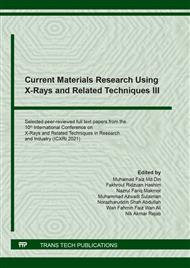[1]
Chindaprasirt, Prinya, Chai Jaturapitakkul, Wichian Chalee, and Ubolluk Rattanasak. Comparative study on the characteristics of fly ash and bottom ash geopolymers., Waste management 29 (2009): 539-543.
DOI: 10.1016/j.wasman.2008.06.023
Google Scholar
[2]
Mustafa Al Bakri, A. M., H. Kamarudin, M. Bnhussain, A. R. Rafiza, and Yahya Zarina. Effect of Na2SiO3/NaOH ratios and NaOH molarities on compressive strength of fly-ash-based geopolymer., ACI Materials Journal 109 (2012).
DOI: 10.14359/51684080
Google Scholar
[3]
Petlitckaia, Svetlana, and Arnaud Poulesquen. Design of lightweight metakaolin based geopolymer foamed with hydrogen peroxide., Ceramics International 45 (2019): 1322-1330.
DOI: 10.1016/j.ceramint.2018.10.021
Google Scholar
[4]
Hwang, Chao-Lung, and Trong-Phuoc Huynh. Effect of alkali-activator and rice husk ash content on strength development of fly ash and residual rice husk ash-based geopolymers., Construction and Building Materials 101 (2015): 1-9.
DOI: 10.1016/j.conbuildmat.2015.10.025
Google Scholar
[5]
Hwang, Chao-Lung, and Trong-Phuoc Huynh. Effect of alkali-activator and rice husk ash content on strength development of fly ash and residual rice husk ash-based geopolymers., Construction and Building Materials 101 (2015): 1-9.
DOI: 10.1016/j.conbuildmat.2015.10.025
Google Scholar
[6]
Yost, Joseph Robert, Aleksandra Radlińska, Stephen Ernst, Michael Salera, and Nicholas J. Martignetti. Structural behavior of alkali activated fly ash concrete. Part 2: structural testing and experimental findings., Materials and structures 46 (2013): 449-462.
DOI: 10.1617/s11527-012-9985-0
Google Scholar
[7]
Masi, Giulia, William DA Rickard, Les Vickers, Maria Chiara Bignozzi, and Arie Van Riessen. A comparison between different foaming methods for the synthesis of light weight geopolymers., Ceramics International 40 (2014): 13891-13902.
DOI: 10.1016/j.ceramint.2014.05.108
Google Scholar
[8]
Bai, Chengying, and Paolo Colombo. Processing, properties and applications of highly porous geopolymers: A review., Ceramics International 44, no. 14 (2018): 16103-16118.
DOI: 10.1016/j.ceramint.2018.05.219
Google Scholar
[9]
Qin, Botao, Yi Lu, Fanglei Li, Yuwei Jia, Chao Zhu, and Quanlin Shi. Preparation and stability of inorganic solidified foam for preventing coal fires., Advances in Materials Science and Engineering 2014 (2014).
DOI: 10.1155/2014/347386
Google Scholar
[10]
Mishra, Devi Prasad, and Samir Kumar Das. A study of physico-chemical and mineralogical properties of Talcher coal fly ash for stowing in underground coal mines., Materials characterization 61 (2010): 1252-1259.
DOI: 10.1016/j.matchar.2010.08.008
Google Scholar
[11]
Rickard, William DA, Arie van Riessen, and Philip Walls. Thermal character of geopolymers synthesized from class F fly ash containing high concentrations of iron and α‐quartz., International Journal of Applied Ceramic Technology 7 (2010): 81-88.
DOI: 10.1111/j.1744-7402.2008.02328.x
Google Scholar
[12]
Hajimohammadi, Ailar, Tuan Ngo, Priyan Mendis, Tuan Nguyen, Alireza Kashani, and Jannie SJ van Deventer. Pore characteristics in one-part mix geopolymers foamed by H2O2: The impact of mix design., Materials & Design 130 (2017): 381-391.
DOI: 10.1016/j.matdes.2017.05.084
Google Scholar
[13]
Korat, L., and V. Ducman. The influence of the stabilizing agent SDS on porosity development in alkali-activated fly-ash based foams., Cement and Concrete Composites 80 (2017): 168-174.
DOI: 10.1016/j.cemconcomp.2017.03.010
Google Scholar
[14]
Yan, Shu, Fanyong Zhang, Shuai Wang, Peigang He, Dechang Jia, and Jinlong Yang. Crystallization behavior and mechanical properties of high open porosity dolomite hollow microspheres filled hybrid geopolymer foams., Cement and Concrete Composites 104 (2019): 103376.
DOI: 10.1016/j.cemconcomp.2019.103376
Google Scholar
[15]
Bai, Chengying, Tao Ni, Qiaoling Wang, Hongqiang Li, and Paolo Colombo. Porosity, mechanical and insulating properties of geopolymer foams using vegetable oil as the stabilizing agent., Journal of the European Ceramic Society 38 (2018): 799-805.
DOI: 10.1016/j.jeurceramsoc.2017.09.021
Google Scholar


